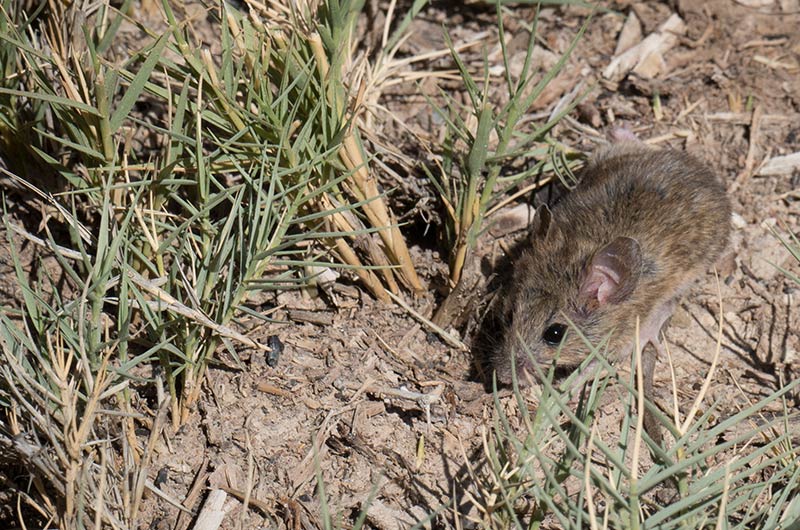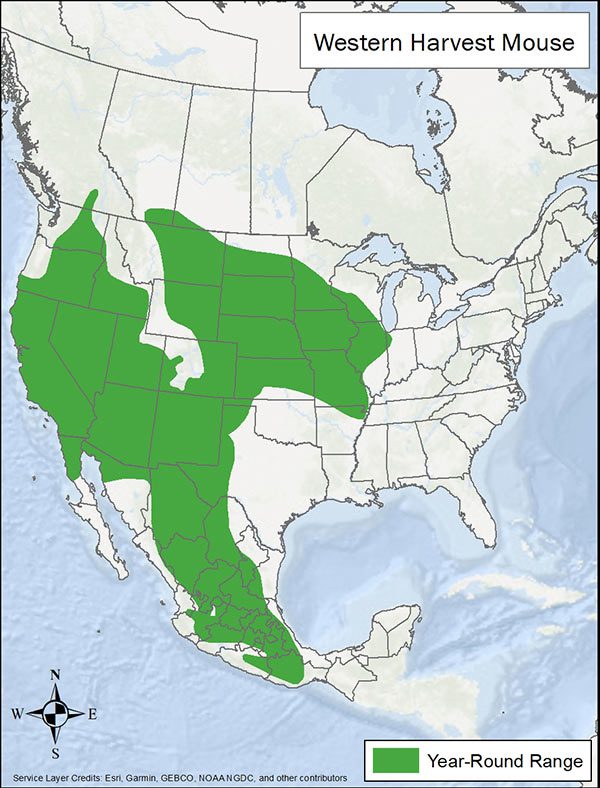LandPKS Learning
Habitat Hub

Western Harvest Mouse
Western harvest mice are active year-round and produce multiple litters each year. One captive female produced seven litters totally 17 young in one year.
Reithrodontomys megalotis
Identification
The western harvest mouse is small, approximately 5.5 in/14 cm, with a scaly, nearly hairless tail being more than half that length. The top and tail is brownish buff to grayish with tan to buffy sides. The belly and bottom of the tail are white or grayish. The buffy-cinnamon to pale flesh colored ears are naked which makes them prominent. The western harvest mouse has grooved incisors similar to other harvest mice. While the western harvest mouse is common to abundant in much of western United States down into Mexico, it is considered Endangered in Alberta and British Columbia.
Observation Tips
The western harvest mouse is found in the North American Great Plains west to the Pacific coast from Canada down into Mexico. They are nocturnal, active a half hour after sunset to a half hour before sunrise so difficult to view. They are most active on moonless, rainy nights.
Interesting Fact
Western harvest mice are active year-round and produce multiple litters each year. One captive female produced seven litters totally 17 young in one year.
Ideal Habitat
The western harvest mouse lives in a wide variety of vegetation communities from old fields, meadows, weedy roadsides, agricultural areas, grassy areas, pine-oak forest, desert-scrub, riparian, sagebrush, shrub-steppe, and sage-grasslands. They prefer dense vegetative cover, including riparian areas or wetlands. This mouse prefers to eat forb and grass seeds, some herbaceous materials and insects. Nests are usually constructed of plant fibers on the ground under heavy vegetation or in shrubs. Lush herbaceous cover (>80% herbaceous cover) is needed to conceal its nests. Nests are grass lined with fine plant material such as dandelion fluff. The nests are about the size and shape of a baseball and located in clumps of grass or shrubs or hanging from vegetation. Western harvest mice use runways through dense vegetation made by voles or other small mammals.

Range map provided by International Union for Conservation of Nature
Management Activities that Benefit Species – Best Management Practices (BMPs)
Light to moderate livestock grazing is compatible with western harvest mice habitat requirements. Rotational grazing that allows some areas with denser vegetation to persist will provide nesting habitat. Western harvest mice will also take advantage of roadsides, fallow fields, and field edges that are not heavily grazed. Riparian and wetland pastures allows managers the ability to carefully graze these systems separately from uplands.
Management Activities to Avoid
Avoid conversion of rangelands to cropland and residential development. Avoid heavy grazing that removes all areas of dense vegetation. Avoid mowing fence lines and cropland edges.
Other Species that Benefit from Similar Habitat Management
Management for western harvest mice benefits other species that prefer dense vegetation including marsh wren as well as their predators, weasels, fox, owls, and snakes.
Download
Download the western harvest mouse Factsheet
Descarga la ficha de el ratón cosechero común
Other Resources
International Union for Conservation of Nature (IUCN). 2014. The IUCN Red List of Threatened Species. Version 2021-1 Western harvest mouse
NatureServe. 2021. NatureServe Explorer: An online encyclopedia of life [web application]. Version 7.1. NatureServe, Arlington, Virginia. Western harvest mouse
Texas Tech University. Mammals of Texas. Western harvest mouse
Photo credit: Alan Harper/Flickr
Mobile App | Data Portal | Knowledge Hub | Habitat Hub | Learning Collections | Blog | About | Contact | Support



